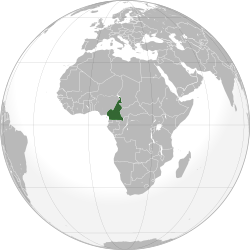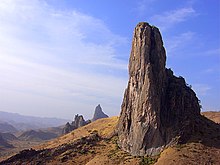
Cameroon, officially the Republic of Cameroon (French: République du
Cameroun), is a country of central and western Africa. It is bordered by
Nigeria to the west; Chad to the northeast; the Central African
Republic to the east; and Equatorial Guinea, Gabon, and the Republic of
the Congo to the south. Cameroon's coastline lies on the Bight of Bonny,
part of the Gulf of Guinea and the Atlantic Ocean. The country is
called "Africa in miniature" for its geological and cultural diversity.
Natural features include beaches, deserts, mountains, rainforests, and
savannas. The highest point is Mount Cameroon in the southwest, and the
largest cities are Douala, Yaoundé, and Garoua. Cameroon is home to over
200 different linguistic groups. The country is well known for its
native styles of music, particularly makossa and bikutsi, and for its
successful national football team. English and French are the official
languages.
Early inhabitants of the territory included the Sao
civilisation around Lake Chad and the Baka hunter-gatherers in the
southeastern rainforest. Portuguese explorers reached the coast in the
15th century and named the area Rio dos Camarões ("River of Shrimp"),
the name from which Cameroon derives. Fulani soldiers founded the
Adamawa Emirate in the north in the 19th century, and various ethnic
groups of the west and northwest established powerful chiefdoms and
fondoms. Cameroon became a German colony in 1884.
After World War
I, the territory was divided between France and Britain as League of
Nations mandates. The Union des Populations du Cameroun political party
advocated independence but was outlawed by France in the 1950s. It waged
war on French and UPC militant forces until 1971. In 1960, the French
administered part of Cameroon became independent as the Republic of
Cameroun under President Ahmadou Ahidjo. The southern part of British
Cameroons merged with it in 1961 to form the Federal Republic of
Cameroon. The country was renamed the United Republic of Cameroon in
1972 and the Republic of Cameroon in 1984.
Compared to other
African countries, Cameroon enjoys relatively high political and social
stability. This has permitted the development of agriculture, roads,
railways, and large petroleum and timber industries. Nevertheless, large
numbers of Cameroonians live in poverty as subsistence farmers. Power
lies firmly in the hands of the authoritarian president since 1982, Paul
Biya, and his Cameroon People's Democratic Movement party. The English
speaking territories of Cameroon have grown increasingly alienated from
the government, and politicians from those regions have called for
greater decentralization and even the secession (for example,: the
Southern Cameroons National Council) of the former British-governed
territories.
Geography

At 475,442 square kilometres (183,569 sq mi), Cameroon is the world's
53rd-largest country. It is comparable in size to Papua New Guinea and
somewhat larger than the U.S. state of California.The country is located
in Central and West Africa on the Bight of Bonny, part of the Gulf of
Guinea and the Atlantic Ocean. Cameroon lies between latitudes 1° and
13°N, and longitudes 8° and 17°E.
Tourist literature describes
Cameroon as "Africa in miniature" because it exhibits all major climates
and vegetation of the continent: coast, desert, mountains, rainforest,
and savanna.The country's neighbours are Nigeria to the west; Chad to
the northeast; the Central African Republic to the east; and Equatorial
Guinea, Gabon, and the Republic of the Congo to the south.
Cameroon
is divided into five major geographic zones distinguished by dominant
physical, climatic, and vegetative features. The coastal plain extends
15 to 150 kilometres (9 to 93 mi) inland from the Gulf of Guinea and has
an average elevation of 90 metres (295 ft).Exceedingly hot and humid
with a short dry season, this belt is densely forested and includes some
of the wettest places on earth, part of the Cross-Sanaga-Bioko coastal
forests.
The South Cameroon Plateau rises from the coastal plain
to an average elevation of 650 metres (2,133 ft). Equatorial rainforest
dominates this region, although its alternation between wet and dry
seasons makes it is less humid than the coast. This area is part of the
Atlantic Equatorial coastal forests ecoregion.
An
irregular chain of mountains, hills, and plateaus known as the Cameroon
range extends from Mount Cameroon on the coast—Cameroon's highest point
at 4,095 metres (13,435 ft)almost to Lake Chad at Cameroon's northern
border at 13°05'N. This region has a mild climate, particularly on the
Western High Plateau, although rainfall is high. Its soils are among
Cameroon's most fertile, especially around volcanic Mount
Cameroon.Volcanism here has created crater lakes. On 21 August 1986, one
of these, Lake Nyos, belched carbon dioxide and killed between 1,700
and 2,000 people.This area has been delineated by the World Wildlife
Fund as the Cameroonian Highlands forests ecoregion.
The southern
plateau rises northward to the grassy, rugged Adamawa Plateau. This
feature stretches from the western mountain area and forms a barrier
between the country's north and south. Its average elevation is 1,100
metres (3,609 ft),and its average temperature ranges from 22 °C (71.6
°F) to 25 °C (77 °F) with high rainfall between April and October
peaking in July and August.The northern lowland region extends from the
edge of the Adamawa to Lake Chad with an average elevation of 300 to 350
metres (984 to 1,148 ft). Its characteristic vegetation is savanna
scrub and grass. This is an arid region with sparse rainfall and high
median temperatures.
Cameroon has four patterns of drainage. In
the south, the principal rivers are the Ntem, Nyong, Sanaga, and Wouri.
These flow southwestward or westward directly into the Gulf of Guinea.
The Dja and Kadéï drain southeastward into the Congo River. In northern
Cameroon, the Bénoué River runs north and west and empties into the
Niger. The Logone flows northward into Lake Chad, which Cameroon shares
with three neighbouring countries.
Demographics

2009 UN estimates place Cameroon's population at 19,522,000. The
population is young: an estimated 40.9% are under 15, and 96.7% are
under 65. The birth rate is estimated at 34.1 births per 1,000 people,
the death rate at 12.2.The life expectancy is 53.69 years (52.89 years
for males and 54.52 years for females).
Cameroon's population is
almost evenly divided between urban and rural dwellers.Population
density is highest in the large urban centres, the western highlands,
and the northeastern plain. Douala, Yaoundé, and Garoua are the largest
cities. In contrast, the Adamawa Plateau, southeastern Bénoué
depression, and most of the South Cameroon Plateau are sparsely
populated.
People from the overpopulated western highlands and the
underdeveloped north are moving to the coastal plantation zone and
urban centres for employment. Smaller movements are occurring as workers
seek employment in lumber mills and plantations in the south and east.
Although the national sex ratio is relatively even, these out-migrants
are primarily males, which leads to unbalanced ratios in some regions.
Both
monogamous and polygamous marriage are practiced, and the average
Cameroonian family is large and extended. In the north, women tend to
the home, and men herd cattle or work as farmers. In the south, women
grow the family's food, and men provide meat and grow cash crops.
Cameroonian society is male-dominated, and violence and discrimination
against women is common.
Estimates identify anywhere from 230 to 282 different folks and
linguistic groups in Cameroon.The Adamawa Plateau broadly bisects these
into northern and southern divisions. The northern peoples are Sudanese
groups, who live in the central highlands and the northern lowlands, and
the Fulani, who are spread throughout northern Cameroon. A small number
of Shuwa Arabs live near Lake Chad. Southern Cameroon is inhabited by
speakers of Bantu and Semi-Bantu languages. Bantu-speaking groups
inhabit the coastal and equatorial zones, while speakers of Semi-Bantu
languages live in the Western grassfields. Some 5,000 Pygmies roam the
southeastern and coastal rainforests or live in small, roadside
settlements. Nigerians, make up the largest group of foreign nationals.
In
2007, Cameroon hosted a total population of refugees and asylum seekers
of approximately 97,400. Of these, 49,300 were from the Central African
Republic (many driven west by war),41,600 from Chad, and 2,900 from
Nigeria. Kidnappings of Cameroonian citizens by Central African bandits
have increased since 2005.
The European languages introduced
during colonialism have created a linguistic divide between the
population who live in the Northwest and Southwest regions and the
French-speaking remainder of the country.Both English and French are
official languages, although French is by far the most understood
language. Cameroonian Pidgin English is the lingua franca in the
formerly British-administered territories.A mixture of English, French,
and Pidgin called Camfranglais has been gaining popularity in urban
centres since the mid-1970s.
Religion
Cameroon has a high level of religious freedom and diversity.
Christians are concentrated chiefly in the southern and western regions,
and Muslims reside in large numbers in every region but are
concentrated in the north. There is significant internal migration.
There are currently no active Islamic political parties. Large cities
have significant populations of both groups, with mosques and churches
often located near each other.
People from the North-West and
South-West provinces are largely Protestant, and the French speaking
regions of the southern and western regions are largely Catholic.
Southern ethnic groups predominantly follow Christian or Animist
beliefs, or a syncretic combination of the two. People widely believe in
witchcraft, and the government outlaws such practices. Suspected
witches are often subject to mob violence.
In the northern
regions, the locally dominant Fulani ethnic group is mostly Muslim,
although some ethnic groups retain native animist beliefs and are called
Kirdi ("pagan") by the Fulani. The Bamum ethnic group of the West
Region is largely Muslim. Native Traditional religions are practiced in
rural areas throughout the country but rarely are practiced publicly in
cities, in part because many indigenous religious groups are
intrinsically local in character.
Miss Cameroon 2012:










No comments:
Post a Comment